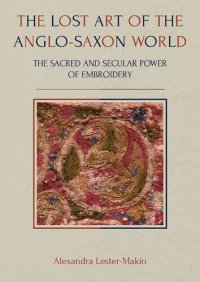
Ebook: The Lost Art of the Anglo-Saxon World: The Sacred and Secular Power of Embroidery (Ancient Textiles)
Author: Alexandra Lester-Makin
- Year: 2019
- Publisher: Oxbow Books
- Language: English
- epub
This latest title in the highly successful Ancient Textiles series is the first substantial monograph-length historiography of early medieval embroideries and their context within the British Isles. The book brings together and analyses for the first time all 43 embroideries believed to have been made in the British Isles and Ireland in the early medieval period. New research carried out on those embroideries that are accessible today, involving the collection of technical data, stitch analysis, observations of condition and wear-marks and microscopic photography supplements a survey of existing published and archival sources. The research has been used to write, for the first time, the ‘story’ of embroidery, including what we can learn of its producers, their techniques, and the material functions and metaphorical meanings of embroidery within early medieval Anglo-Saxon society.
The author presents embroideries as evidence for the evolution of embroidery production in Anglo-Saxon society, from a community-based activity based on the extended family, to organized workshops in urban settings employing standardized skill levels and as evidence of changing material use: from small amounts of fibers produced locally for specific projects to large batches brought in from a distance and stored until needed. She demonstrate that embroideries were not simply used decoratively but to incorporate and enact different meanings within different parts of society: for example, the newly arrived Germanic settlers of the fifth century used embroidery to maintain links with their homelands and to create tribal ties and obligations. As such, the results inform discussion of embroidery contexts, use and deposition, and the significance of this form of material culture within society as well as an evaluation of the status of embroiderers within early medieval society. The results contribute significantly to our understanding of production systems in Anglo-Saxon England and Ireland.
Table of Contents
1. Introduction
2. Studying embroidery: the data and the difficulties
3. Kempston: The biography of an embroidery
4. Embroidery in production
5. Embroideries and their context
Bibliography
Glossary of terminology
Catalogue of Surviving Insular Embroideries
The author presents embroideries as evidence for the evolution of embroidery production in Anglo-Saxon society, from a community-based activity based on the extended family, to organized workshops in urban settings employing standardized skill levels and as evidence of changing material use: from small amounts of fibers produced locally for specific projects to large batches brought in from a distance and stored until needed. She demonstrate that embroideries were not simply used decoratively but to incorporate and enact different meanings within different parts of society: for example, the newly arrived Germanic settlers of the fifth century used embroidery to maintain links with their homelands and to create tribal ties and obligations. As such, the results inform discussion of embroidery contexts, use and deposition, and the significance of this form of material culture within society as well as an evaluation of the status of embroiderers within early medieval society. The results contribute significantly to our understanding of production systems in Anglo-Saxon England and Ireland.
Table of Contents
1. Introduction
2. Studying embroidery: the data and the difficulties
3. Kempston: The biography of an embroidery
4. Embroidery in production
5. Embroideries and their context
Bibliography
Glossary of terminology
Catalogue of Surviving Insular Embroideries
Download the book The Lost Art of the Anglo-Saxon World: The Sacred and Secular Power of Embroidery (Ancient Textiles) for free or read online
Continue reading on any device:

Last viewed books
Related books
{related-news}
Comments (0)